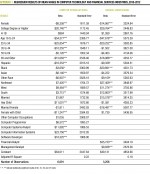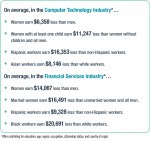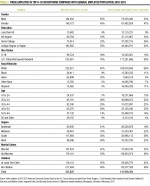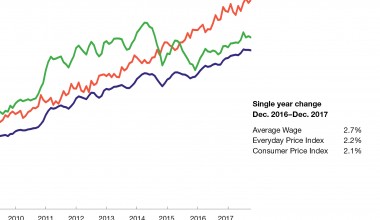H-1B Visas: No Impact on Wages
A vast number of studies supports arguments on either side of the divisive H-1B wage debate. This brief first analyzes those arguments. Then it uses averaged and aggregated 2010-2012 Census data to explore the relationship between visa status and average wages for occupations for which employers most frequently request H-1B visas.
Since the late 1990s, the bulk of H-1B visas have been distributed to computer technology and other STEM (science, technology, engineering, and math) firms. This has resulted in the conviction by some that U.S. companies are choosing not to hire U.S. workers in favor of cheaper H-1B workers. To understand this debate, it is useful to analyze both the supply-side and demand-side arguments.
On the supply side, various groups have expressed concern that the technology industry does not actually need H-1B visas, citing studies that find there are many U.S. computer technology graduates without jobs.
A 2013 analysis by Salzman, Kuehn, and Lowell, for example, shows that over the past decade, STEM students have improved on test scores, and the number of STEM graduates has been increasing. The analysis uses these data to argue that there is a sufficient flow of computer technology students in the pipeline to meet demand. Moreover, with one out of every two IT (information technology) graduates unable to find employment, analysts argue that there is no need for foreign workers to fill these positions.
Groups use studies like this one to argue that firms purposefully ignore a supply of suitable U.S. workers because they can pay H-1B workers less than their U.S. citizen or permanent resident counterparts.
Meanwhile, on the demand side, business proponents argue that there is a real worker shortage in the computer technology industry. Supporting these arguments is a 2013 study by Rothwell and Ruiz; they find that H-1B workers actually earn more than Americans, and the jobs they take have been hard to fill, suggesting that H-1B workers are filling a skills gap in the American workforce.
In their analysis, Rothwell and Ruiz use 2011 job postings data from the Conference Board. They find that job postings that required STEM knowledge took much longer to fill than other jobs, even after accounting for education, experience, wage rates, and geographic location. They then turn to 2010 H-1B petitions data and find that H-1B workers earn more than Americans when controlling for age, education, and occupation.
Businesses use studies like this one to argue that H-1B workers provide skills that Americans do not have. Therefore, they do need H-1B workers, and they need them now.
In reality, both sides could be right. The number of STEM graduates in general and computer technology graduates in particular may very well be increasing, as the first argument asserts. But this increase in the flow of labor does not necessarily lead to an immediate jump in the supply of computer technology job occupants. There is a lag in the time it takes for steadily increasing labor flows to meet ongoing demand. This may be the case for STEM fields.
The demand-side claims could also be true: There is a shortage of computer technology workers now. The long-term supply could be slowly increasing while an immediate demand for labor in specific industry niches remains.
It is important to understand the distinction between an argument that focuses on the long-term flow of labor and an argument that focuses on immediate demand because both arguments have been deeply politicized and oversimplified.
In this brief, AIER focuses on the wages of two industries with high H-1B demand now. It will not answer the question of whether or not there is an adequate U.S. supply of labor in the pipeline to meet anticipated demand. Nor will it determine if companies are purposefully hiring lower-wage foreign-born workers. It will, however, determine whether in the current period, the number of H-1B visas in an industry is associated with higher or lower average wages in that industry, or whether H-1B visas have any effect on average wages at all.
In both industries, gender, race, and ethnicity are significant in accounting for differences in earnings.
Wages for High Demand Jobs
AIER uses Census data from the 2010 to 2012 American Community Survey to determine whether or not the number of H-1B visas affects average wages in industries with the highest H-1B demand.
Tables 1 and 2 on pages 2 and 3 show the top occupations for which industries demand H-1B visas, their average wages, and the demographic characteristics of all workers in these occupations. (For more information, see AIER’s April 2014 Issue Brief, H-1B Jobs: Filling the Skill Gap)
For each occupation, Table 1 shows 2013 data for average wages, the number of visas requested, total employment, and the share of H-1B visas requested out of total employment. Of the top ten occupations for which H-1B visas were requested, employers requested the most visas for computer technology occupations. The number of visas requested (624,783) in computer technology is the equivalent of 23% of the highly skilled computer technology workforce. In absolute numbers, the most employer requests came for systems analysts and computer programmers and the catchall category of “all other” computer occupations.
Meanwhile, 62,939 visas requested in the financial services industry equals only 3% of that highly skilled workforce. In absolute numbers, the demand was around 20,000 for each occupation; these requests accounted for a relatively small share of jobs, ranging from 2% for accountants and auditors to 8% for financial analysts. At the same time, the wages in jobs with a high H-1B demand are quite diverse, from about $57,000 to $118,000 a year, and they do not correspond with the comparative level of demand.
Many demographic characteristics, such as education, age, race, and citizenship status, affect wages. As Table 2 shows, there is a slightly larger share of male workers (55 percent) in jobs with high H-1B visa demand than in the general employed population (53 percent). Workers in these jobs are highly educated as well: 55 percent hold more than a college degree compared to 32 percent in the general working population. Racially, workers in jobs with high H-1B demand are predominately white (67 percent), comparable to the population at large.
Across racial and ethnic groups, blacks and Hispanics are underrepresented in jobs with a high H-1B demand compared to the overall working population, while Asians are overrepresented. Twenty percent of workers in jobs with a high H-1B demand is Asian, as compared to 8 percent in the general working population.
Most workers in jobs with a high H-1B demand are between the ages of 25 and 44, a slightly larger share than is found in the general working population. There is also a slightly larger share of these workers in the Northeast (21 percent) and West (26 percent). This most likely is the result of the plethora of technology jobs in the Silicon Valley and the Boston region. Finally, compared to the general working population, a slightly larger share of workers in these occupations is not married (53 percent compared to 48 percent), and a larger share has no children (65 percent compared to 58 percent).
If H-1B visa-holders were hired because of their lower wages, we would expect this to result in lower wages for H-1B workers. To test the extent to which H-1B status accounts for differences in wages between H-1B visa holders and their U.S. counterparts, AIER uses statistical techniques (ordinary least squares regression) to assess the effects of each of these demographic and employment characteristics separately from H-1B visa status. The results of the analysis are discussed below.
Findings
Contrary to both arguments presented at the beginning of this brief, having H-1B visa status does not account for differences in average wages in six highly skilled computer technology occupations or in three highly skilled financial services occupations. These represent the largest demand for H-1B visas.
The statistical results for both industries are presented in the Appendix. In both industries, after taking into account age, race, ethnicity, region, and occupation, we cannot attribute any wage differences in these occupations to holding an H-1B visa.
If H-1B visas do not account for wage differences, what factors do?
There is a “marriage penalty” for women in the finance industry and a “child penalty” for women in the computer technology industry.
Gender
In both industries, gender is a significant factor in accounting for differences in earnings. If we separate out gender from the other demographic characteristics, we find that in the computer technology industry, women in our six occupations earn $6,358 less than their male counterparts. In the finance industry, the wage differential between men and women is far greater. After taking all other characteristics into account, women on average earn $14,067 less than men.
This analysis also seeks to determine if marriage and having children account for differences in earnings for women.
In computer technology occupations, the results indicate that, on average, women with children earn far less than other workers, but married women are not penalized for being married. Women with at least one child earn $11,247 less than everyone else (women without children and all men).
In financial services occupations, the opposite prevails. While married women earn far less than men, they are not penalized for having a child. Married women’s average earnings are $16,491 less than unmarried women and all men.
While our analysis can tell us that there is a “marriage penalty” for women in the finance industry and a “child penalty” for women in the computer technology industry, it does not tell us why this is so.
After taking into account differences in education, age, and geography, a black, highly skilled, finance worker earns far less than a white worker.
Race and Ethnicity
Race and ethnicity account for wage differentials in both industries. In the computer technology industry, on average, a Hispanic worker in this group of six occupations earns $16,353 less than a non-Hispanic worker. This is a larger differential in earnings than racial groups of color, such as blacks (whose earnings are expected to be $3,656 less than white workers), Asians (whose earnings are expected to be $8,146 less than white workers), and workers who identified “other” as their race ($6,907 less than whites).
In the financial services industry, on the other hand, black workers’ average earnings are $20,691 less per year compared to white workers’. This means that after taking into account differences in education, age, and geography, a black, highly skilled, finance worker earns far less than a white worker. Meanwhile, those who marked “other” as their race earn, on average, $9,109 less than white workers. There is no statistically significant difference between the wages of whites and Asians in finance, but on average, Hispanics earn $9,328 less than non-Hispanics.
These results show that race and ethnicity matter when interpreting wage differences in occupations with a high H-1B demand. Despite the perception that H-1B status affects wages, once we take into account gender, race, and ethnicity, there is no observable wage differential between U.S. and H-1B workers that we can independently attribute to visa status.
Age
Workers 45-to-54 are, on average, at their peak earning years in both industries. We find that, on average, the earnings of older workers are $15,083 less than the earnings of workers in the 45-to-54 age cohort.
Region
In both industries, a worker’s geographic region also accounts for significant differences in wages. In the computer technology industry, average earnings of workers in the Midwest are lower than in other parts of the country. A highly skilled computer technology worker in the West, for instance, is expected to earn, on average, almost $9,484 more than a comparable worker in the Midwest.
In the financial services industry, we find that there are larger wage differentials across regions of the United States. On average, a highly skilled financial services worker earns $27,408 more in the Northeast than a Midwestern counterpart. A worker in the South earns, on average, $12,800 more, and a worker in the West earns, on average, $11,274 more.
Implications
This analysis shows that there are five factors that yield large differences in annual expected earnings in highly demanded H-1B jobs: gender, race, ethnicity, age, and region. We cannot attribute any differences in average earnings to H-1B visa status.
Where, then, should this conclusion take us? Do we need to expand the supply of STEM workers? Employers and business interests will say yes. In response to those who fear that expanding the pool of highly skilled H-1B workers will push down wages in the computer technology and financial services industries, our analysis finds no such impact for the time period we studied.
U.S. workers and their advocates, however, may say that just because H-1B visas have not pushed down wages in one time period does not mean this has not occurred at other times or that it will not occur in the future. This is quite true; a definitive answer requires a longer time frame for analysis.
The answer to the question of whether or not to expand the H-1B visa program is a complicated one. Historically, we have turned to Washington to resolve such complicated issues. However, our statistical analysis leads us to believe that a path to pragmatic problem solving is within reach.
If employers in the computer technology and financial services industries need additional workers, this quantitative analysis suggests that there is untapped human capital potential. Women and people of color currently are paid less in both industries and are underrepresented in computer technology.
Based on this limited snapshot, we do not find any evidence to confirm the argument that employers are using H-1B visa holders to push down wages in these particular occupations. We do, however, find that there are systematic wage differences in these computer technology and financial services occupations by race, ethnicity, gender, marital status, and children in the household.
[pdf-embedder url=”https://www.aier.org/wp-content/uploads/2014/09/IB20140918_0.pdf“]








